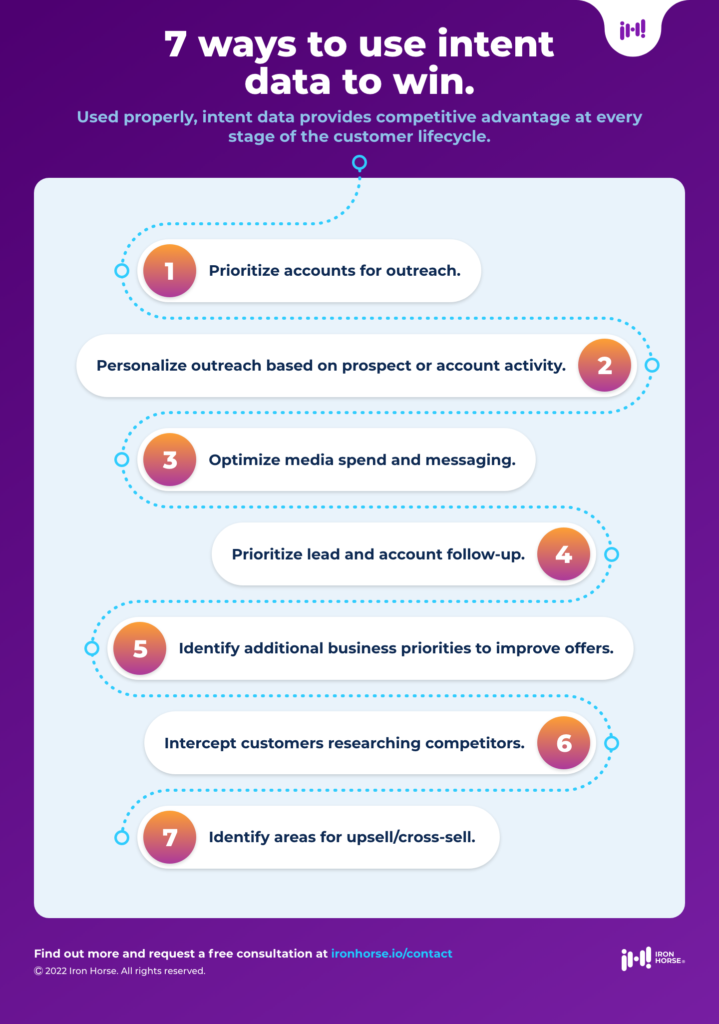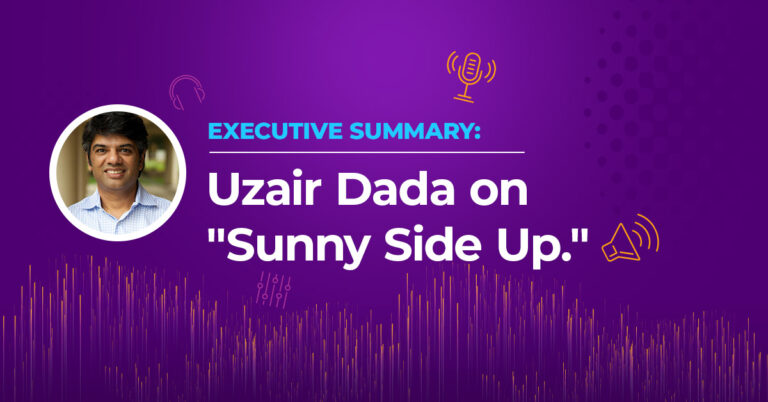Companies that took the initial plunge with intent data skewered their competitors. Getting to the table first allowed them to shape the conversation, setting themselves up as the solution to beat. Those early adopters could frame their products based on the client’s needs and values, while competitors had to play catch up.
Fast forward to today when, according to our recent research, 99% of B2B enterprise tech marketers are using intent data and 61% are combining intent data from two or more providers. In this environment, competitive advantage does not come from simply having intent data, but how well you use it.
How to use intent data effectively.
Here are 7 ways to put intent data to use across the customer lifecycle.
In our experience, most enterprise B2B organizations are applying intent data in one or two of these ways. If that’s you, you’re leaving intelligence on the table. Let’s look at each use case in more detail.
1. Prioritize your accounts list.
When you have a target account list of hundreds, prioritizing based on company size, industry and other firmographics will only get you so far. Even with a smaller batch of accounts, there’s a lot of room for ineffective outreach. The first and most obvious use of intent data is helping sales focus their efforts on accounts that are currently in-market. Narrowing the account list also enables both marketing and sales to be more strategic with messaging, ad placements, and offers.
What to look for: Companies on your target account list that are actively searching topics related to your solution. Also look for companies that are not on your list, but are demonstrating behavior that indicates they might be worth a second look—assuming they check the other boxes, like size and market.
What to do with it: Give the info to your sales team so they can be more strategic about who they reach out to, and when. Provide regular updates so sales knows when account priorities change.
Tip: Include your competitors’ names, products, and branded terms among your intent keywords. If your intent provider doesn’t already track these terms, ask them if they can go forward.
2. Create more relevant messaging, content and offers.
Busy B2B buyers don’t have time to wade through irrelevant offers and conflicting messaging. The second most important use for intent data is to help create more personalized experiences for prospects. 3rd party data can’t tell you what specific problems specific people in your database are trying to solve. But it can give you a pretty good idea of what topics are most important to buyers at target accounts. You absolutely should be refining your messaging and content accordingly.
For instance, you might use intent data to:
- Find out which accounts in your database are currently researching the topic of an upcoming webinar or event and send personalized emails to prospects from those accounts.
- Segment new leads into the most appropriate nurture stream based on recent account activity.
- Refine outreach messaging and offers to address areas topics that see the most engagement.
This level of personalization is daunting when you have a massive account list. Using intent data to first narrow your list to in-market accounts makes this effort more doable. And, when you use intent data rather than hunches to guide that personalization, it becomes much more effective.
What to look for: Topics that are trending for target accounts. If you have this information by persona, even better.
What to do with it:
- Marketing: Serve up persona- and buying-stage-specific messaging and content about those topics via ads, email nurtures, and the pages on your website those accounts visit most (e.g. home).
- Sales: Send customized emails to contacts from highly engaged accounts with messaging and content related to those topics.
Tip: Just because a topic is trending for a company doesn’t mean it’s trending for a specific person in the company. It might sound obvious, but only engage a person with messaging if it actually makes sense for their persona. For example, if a key account shows a lot of engagement around “anti-virus software,” it makes sense to use that messaging with IT and the CIO, but would probably be a miss for prospects in marketing, finance, or sales.
3. Optimize your media spend.
Intent data from a media platform can provide a wealth of information about who your target audience is and what they are looking for. This information can be especially useful when using paid media as part of your account based marketing strategy. Some vendors can even provide this data at the person level, which can help revenue teams build a more accurate picture of who is in the buying group and what role they might play within it. Whether your intent data is at the account-level or person-level, it enables you to make much more strategic decisions about how to allocate your media budget.
What to look for: Which channels and messages see the most engagement from target accounts.
What to do with it: Reallocate your media budget to highly active accounts and, if the data is available to you, personas. For instance, you might reduce the number of general ads you place on a broad-based platform, such as Facebook, and shift some of that spend over to a subgroup where the most active titles in your target accounts are likely to hang out. Some platforms allow you to target specific audiences based on intent data. When doing so, you’ll get the most impact when you also revise your messaging to appeal to those personas.
Tip: Look for “look-alike accounts” in the data—accounts that behave like your target accounts but aren’t already on your radar—and consider adding them to your account list.
4. Prioritize leads.
You just downloaded 100 leads from the trade show. How does your sales team know who to contact first? Intent data allows sales reps to be much more strategic in this situation than they could be without it. Rather than guessing, they can start with the leads from accounts that appear to be actively evaluating solutions.
Intent data also helps revenue teams responsively shift resources to where they can have the most impact. For example, while it may be a best practice to reach out to certain leads 15 times, it’s not sustainable—or recommended—to do this for every lead. Intent signals take a lot of the guesswork out of deciding when to apply this level of effort and where to scale back.
What to look for: Cross-reference new lead lists against account engagement insights from intent data—as well as your own first party data.
What to do with it: Use this information to be more strategic about who to follow up with, how often, and when.
5. Uncover new focus areas.
Organizations rarely focus on a single priority or initiative. A less common but effective use case for intent data is uncovering additional focus areas competing for decision makers’ attention—and then using that knowledge to position your solution as the most important.
For example, a business intelligence platform provider might be targeting outreach to accounts actively searching for predictive analytics. Casting a wider keyword net reveals that one account is also heavily researching enterprise resource planning (ERP) solutions. A savvy rep could use this knowledge to proactively position accurate, up-to-date business intelligence as a prerequisite for effective resource planning. They could also explain how business intelligence drives more impact and is a lower risk investment than an ERP.
What to look for: Look for high levels of target account activity around business solutions that do not directly compete with your offering but may be of interest to your target audience. For example, a webinar platform vendor might also monitor target account activity around content analytics platforms and sales engagement tools.
What to do with it: Position offerings in the context of the range of things account decision makers care about, rather than just against the competition for your solution.
Tip: If this positioning resonates with key accounts in sales outreach, consider creating an asset that can be discovered by prospects as part of a self-service buying journey.
6. Head off churn.
Your customers are satisfied, right? A flurry of activity from a key account around your competitors’ offerings may tell you otherwise. Are the end users of your solution not getting what they need from it? Are members of another department researching a competitive solution? Catching both of these cases early can make a significant difference in whether customers continue to use your solution or go somewhere else.
What to look for: Current clients that are actively researching competitive solutions (competitor names or branded terms).
What to do about it: Alert the account team about the activity, providing as much detail as possible about the account activity so they can be prepared to address specific customer concerns.
Tip: Combine this with information you have about account health, such as frequency and severity of tech support tickets, and its renewal cycle to make outreach more precise.
7. Identify opportunities to upsell and cross-sell.
In our survey of enterprise B2B tech organizations, 67% of respondents identified growing revenue through upselling and cross-selling within existing accounts as a key challenge for the marketing organization. This is another area where strategic and careful use of intent data can provide a significant leg up!
What to look for: Current clients that are actively researching topics related to other solutions your company offers (including those from your competitors).
What to do with it: Use this information to fuel direct, personalized outreach from sales.
Tip: Tell the account manager for the account in question as they will be able to directly action the information.
The Iron Horse insight.
Used correctly, intent data helps revenue teams to rapidly shift resources to target the most engaged, high-value accounts. This approach requires tight alignment between marketing and sales. Crucially, the entire revenue team must know how to access, read, evaluate and act on intent signals.
We talked a lot more about how to use intent data effectively in our From Insights to Actions roundtable series.




